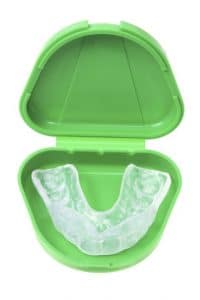The temporomandibular joint (TMJ) is the name of the joint located on either side of your head, just in front of your ears. These joints connect your mandible (jawbone) to your temporal bone (skull). The TMJ, which can rotate and move forward, backward and side to side, is considered one of the most complex joints in the body. This joint, in combination with other muscles and ligaments, lets you chew, swallow, speak and yawn. When you have a problem with the muscle, bone or other tissue in the area in and around the TMJ, you may have a TMD.

Symptoms
Signs or symptoms of TMDs include pain and tenderness in or around the ear, the jaw joint, or the muscles of the jaw, face or temples. Other symptoms are problems opening or closing your mouth, and a clicking, popping, crunching or grinding noise when you chew, yawn, or open your mouth. TMDs may be linked with neck pain and headaches.
Causes
In most cases, TMDs are caused by a combination of factors like jaw injuries and joint disease, such as arthritis. It is believed that bruxism (tooth clenching or grinding) and head or neck muscle tension may make TMD symptoms worse. Stress is also a possible factor. However, it is not clear if stress causes TMDs or is a result of them.
Other things that may lead to TMDs are partial or full dentures that are not the right fit and certain habits such as fingernail biting and pen or pencil biting.
Self care
Most patients with TMDs get better by themselves without any treatment. To help yourself deal with the issues associated with TMD, you can try some of the following:
Eat soft foods
Limiting your diet to soft foods during a flare-up of TMD can decrease jaw pain and discomfort. If you do eat hard foods (eg, raw carrots), be sure to cut them into tiny pieces or take very small bites. Also, eating sticky or chewy foods—and even chewing gum—can aggravate your symptoms, so limit these types of food.
Do jaw exercises
Jaw stretches and other face exercises can help ease TMJ disorder symptoms. Your doctor, dentist, or a physical therapist can show you how to do at-home jaw exercises to stretch your jaw muscles. He or she can also show you how to massage the muscles in your jaw.
Learn and use stress management techniques
Stress can aggravate TMJ pain—and that’s why stress management techniques are so important to do. Examples of ways to control your stress at home are doing yoga poses, deep breathing, guided imagery, and meditation.
Limit extreme jaw movements
Yawning and yelling are examples of extreme jaw movements that can place tension on the TMJ. Be aware of overusing your jaw muscles because it can lead to jaw strain.
Consciously relax your jaw
When you are relaxed, your teeth should be slightly apart and your tongue should rest on the floor of your mouth with your lips barely touching or slightly apart. There should be a slight space between your upper and lower teeth except during chewing, speaking or swallowing.
Use heat or cold therapy
Applying moist, warm heat packs or ice packs to your jaw can help to relax your jaw and face muscles. Your dentist will let you know how long to leave the ice pack or heat pack on, as well as the proper placement of the packs.
How your dentist can help
After a thorough examination and, if needed, appropriate x-rays, your dentist may suggest a plan to treat your TMD. This treatment plan may include:
- relaxation techniques
- a referral to a physiotherapist, a chiropractor or a behavioural therapist to help you ease muscle pain
- medicine for pain, inflammation or tense muscles
- Methods to improve sleep
- Fitting and creation of a night guard, also called an occlusal splint. It is made of clear plastic and fits over the biting surfaces of the teeth of one jaw so that you bite against the splint rather than your teeth. This often helps your jaw joints and muscles to relax
- If your pain continues, your dentist may also refer you to an oral and maxillofacial surgeon who has extra training in TMDs
- Surgery is rarely used to treat TMDs; however, if none of the other treatments has worked, or if it is very hard to open your jaw, you may need surgery. If you do need surgery, your dentist will refer you to an oral and maxillofacial surgeon with expertise in temporomandibular joint surgery




